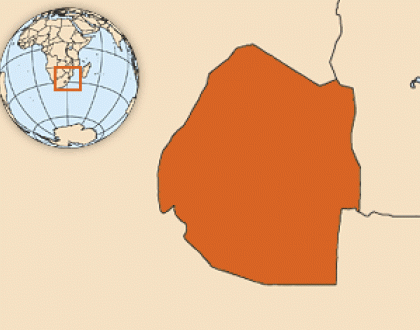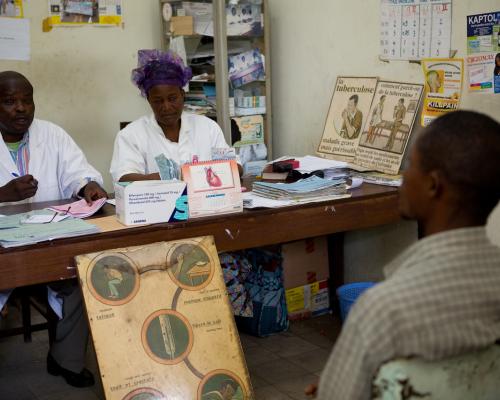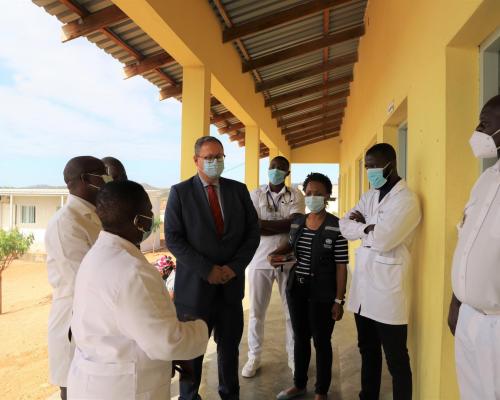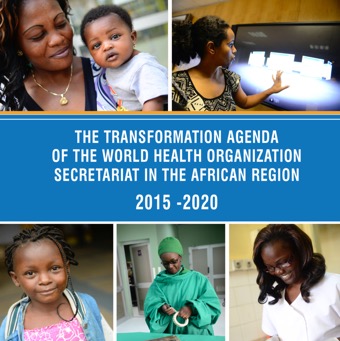| Total population (2015) | 1,287,000 |
| Gross national income per capita (PPP international $, 2013) | 6 |
| Life expectancy at birth m/f (years, 2015) | 57/61 |
| Probability of dying under five (per 1 000 live births, 0) | n/a |
| Probability of dying between 15 abd 60 years m/f (per 1 000 population, 2013) | 425/326 |
| Total expenditure on health per capita (Intl $, 2014) | 587 |
| Total expenditure on health as % of GDP (2014) | 9.2 |
Eswatini
Informação do País
Data & Statistics

Country Health Topics
OVERVIEW
The World Health Organization (WHO) Eswatini is the United Nations' lead agency in health. WHO has been offering technical advisory assistance to the Ministry of Health since 11th July 1973 promoting Sustainable Development Goal 3 (SDG) – Health and well-being in the country. This relationship has been nurtured over the years through WHO offering scientifically proven recommendations to the Ministry of Health which have been very instrumental in the growth of the health sector in the Kingdom. Worth mentioning, WHO Eswatini also works with different health partners including local and international non-governmental organizations and donor organizations to bolster health systems in Eswatini.
WHO’s work is centred around three interrelated pillars that are aligned with the Sustainable Development Goals which focus on ensuring more Emaswati are;
Benefitting from universal health coverage
Better protected from health emergencies and,
Enjoying better health and well-being.
The country office is composed of competent and experienced technical experts who provide evidence-based solutions to interventions meant to strengthen health information systems. WHO uses its influence to push for the support for transformational public health policy in Eswatini and the greater African region meant to benefit all Emaswati.
In 2023, WHO Eswatini, like the rest of the world, celebrated 75 years of existence.
The below health profiles give a brief description of what the World Health Organization Eswatini Country Office is doing in the respective health pillars to achieve and increase health coverage in the Kingdom.
IMMUNIZATION AND VACCINE DEVELOPMENT
The Eswatini Expanded Program on Immunization (ESEPI) is committed to achieve and maintain high immunization coverage by reaching targeted population with quality and potent vaccines. The program also aims at reducing the number of unvaccinated and under vaccinated targeted population and sustaining availability of current vaccines given as per recommended vaccination schedule. Furthermore, the program, in line with the Immunization Agenda 2030 (IA2030) and Regional Immunization Strategic Plan 2021-2030, intends to introduce targeted new vaccines as per the country epidemiological situation. WHO WHO has provided technical and financial support for the introduction and roll out the HPV vaccine amongst girls aged 9-14 years in response to prevention of cervical cancer which is the leading cancer in the country in women aged 15-44 years.
The program continuous to contribute towards Wild Polio Virus eradication and end circulating Vaccine Derived Polio Virus transmission. WHO supported technically and financially towards the establishment of polio environmental surveillance aligning it with the GPEI newly launched strategy; Polio Eradication Strategy 2022-2026.
The programme’s goal is to reduce morbidity and mortality due to Vaccine Preventable Diseases. The objectives of the programme are according to immunization service systems components which include the following:
Service delivery
Sustainable financing
Vaccine supply, quality, and cold chain
Accelerated disease control, eradication, and elimination
Vaccine preventable diseases, sentinel surveillance, Adverse Events Following Immunization (AEFI) monitoring and laboratory support
Immunization data quality and assessment
Demand generation, Advocacy, communication, social mobilization
Leadership and programme management
For more information please contact: Dr Khumalo Lonkululeko at khumalol [at] who.int (khumalol[at]who[dot]int)
EMERGENCY PREPAREDNESS AND RESPONSE
Emergencies are inevitable, have long-lasting influence on healthcare systems and often disrupt the discourse of development agenda. The WHO in Eswatini strives to enhance its preparedness to handle emerging disasters to ensure that less people are affected including the disruption on their livelihoods.
Eswatini is implementing the International Health Regulations (IHR) and Integrated Disease Surveillance and Response (IDSR) since 2010 to prevent, detect and respond to public health events of international concern. The programme contributes towards operational readiness to respond to health emergencies by assessing the country’s all-hazards emergency preparedness capacities and through capacity development for managing risks and vulnerabilities. Polio eradication and transition plans in partnership with the Global Polio Eradication Initiative aims towards preventing disease outbreaks and pandemics. The country scaled- up response during the COVID-19 pandemic by rapidly detecting resurgences, assessing, and communicating risks, and by rapidly putting in place mitigation measures. The country reconstituted the Public Health Emergency Management Committee (PHEMC) and all PHEMIC members were oriented on the incident management system which led to improved coordination of COVID- 19 response at all levels.
Emergency preparedness builds on the International Health Regulations (2005), a set of procedures to prepare for and respond to public health threats. Significant progress has been made in emergency preparedness capacities including follow up actions on the voluntary joint external evaluation, Intra Action-action review for COVID-19 response and simulation exercises. The national Action Plan for Health Security (NAPHS) was also developed in line with recommendations for the Joint External Evaluation (JEE) conducted in 2018.
There is also continued support for the implementation of the national polio transition plan aimed towards polio eradication initiative. The country maintains the “polio-free status”, a global goal of polio eradication.
For more information please contact: Dr Lonkululeko Khumalo at khumalol [at] who.int (khumalol[at]who[dot]int)
NON-COMMUNICABLE DISEASES PREVENTION AND CASE MANAGEMENT
Non-communicable diseases (NCDs), also known as chronic diseases, are diseases that are not passed from person to person. NCDs are among the top 10 diseases with highest morbidity and mortality in Eswatini According to the National Strategic Plan for the Prevention and control of non-communicable diseases (2021 – 2023), in Eswatini, the probability of dying between the age of 30 -70 years is 21 %. These deaths can be attributed to the four main NCDs, mainly cardiovascular diseases, cancer, chronic respiratory diseases, and diabetes. According to the last STEPwise approach to Surveillance (STEPS) conducted in 2014, the burden of diabetes and cardiovascular diseases is high with a prevalence of hypertension estimated to be approximately 24.5% in Eswatini.
The four major NCDs mainly share four common risk factors: tobacco, insufficient physical activity, unhealthy diet, and excessive alcohol use. These modifiable risk factors and can be addressed through behavior change before they manifest as raised blood pressure, raised blood sugar, raised blood lipids, and overweight and obesity. In Eswatini, the prevalence of physical inactivity is 15.3%, most of the adult population eat less than five servings of fruits and/or vegetables on average per day, 13% of the adult population drink alcohol and the prevalence of smoking among the adult population stands at 6% (STEPS, 2014). WHO is keen on reducing the major risk factors for non-communicable diseases (NCDs) – tobacco use, physical inactivity, unhealthy diet, and the harmful use of alcohol through advocacy including the development of strategies, policies, national plans for the control of NCDs and programmes aimed at preventing deaths from NCDs.
The implementation of the WHO Framework Convention on Tobacco Control is done through the FCTC 2030 Project which has led to greater awareness nationally on the harmful effects of tobacco use.
In addition, there is a noted increase in the burden of cancers and Mental health disorders. Mental health is increasingly acknowledged as an important public health concern in Eswatini. Population-level data is scarce for the country, but small-scale studies show that common mental health disorders (CMD) such as depression, anxiety and substance misuse are highly prevalent in the population. Suicide rates have also been on the rise.
The National Cancer Registry data, 2020 shows a higher proportion of mortality in women from cancers, with cervical cancer being the leading cause.
WHO continues to:
Advocate for improved and sustainable financing for the prevention and control of communicable and non-communicable diseases
Advocate for equitable distribution of resources and health services related to communicable and non-communicable disease prevention and control.
Offer technical assistance towards scale-up delivery of integrated health services on communicable and non-communicable diseases in health care facilities.
Encourage collaboration, accountability mechanisms and engagement of communities and other non-health actors to champion for the implementation of quality , patient-centred communicable disease and non-communicable disease prevention and control interventions
Ensure availability, access and affordability of essential medicines and health technologies in primary health-care facilities
Support strengthening of the health information systems through Health information strategy implementation and monitoring of key health indicators. This is done by supporting the Ministry periodic surveys (STEPS) and program reviews to inform national NCD programming.
HEALTH SYSTEM STRENGTHENING
A well-functioning health system working in harmony is built on having trained and motivated health workers, a well-maintained infrastructure, and a reliable supply of medicines and technologies, backed by adequate funding, strong health plans and evidence-based policies.
WHO in the Kingdom of Eswatini assisted in coordinating support from partners and supported the MOH in its stewardship role such as revision of regulatory and legislative instruments and documents. It has supported the analysis of the health financing landscape in order to propose a more sustainable and adequate financing for health. WHO also supported the tracking of health expenditures to inform decision making at the highest level.
WHO has supported the Ministry of Health to review its information system, its Human Resources for Health strategic plan, and the National Health Sector Strategic plan
WHO has provided technical and financial support the introduction and roll out the International Disease Classification version 11 (ICD11). Eswatini was using the ICD 9. WHO aslo worked with the Ministry of Home affairs and other relevant stakeholders to develop and costed strategy for the Civil Registration and Vital Statistics, and supported its implementation.
In the area of Human Resources for Health, WHO supported the review of HRH strategy and did a health labor market analysis to inform the development of a new HRH strategy.
WHO has supported the development of an Essential Health Care Package and is currently supporting a review and update of EHCP.
For more information please contact: Dr Mekdim Ayana at ayanam [at] who.int (ayanam[at]who[dot]int)
REPRODUCTIVE MATERNAL, NEWBORN, CHILD AND ADOLESCENT HEALTH (RMNCAH-N)
Maternal newborn health
Maternal deaths have consequences on individuals, families, communities, and the social-economic status of the country. The country is experiencing a high maternal mortality rate (MMR) estimated at 452/100 000; most of which occur during the postpartum period, and they are due to preventable causes. On average, 32 women die each year because of complications of pregnancy and delivery yet 88 % of births are delivered by skilled birth attendants. There’s high HIV positivity among pregnant women and also a high percentage of mothers who test positive during ANC (93%) who are enrolled into treatment and care. Neonatal and infant mortality rate stand at 20 and 50 per 1000 live births correspondingly.
The country is implementing evidence based SRMNCAH-N interventions which aims at reducing mortality, morbidity, fertility, improving the nutritional status and conducting effective maternal, perinatal, and death surveillance and response (MPDSR) surveillance.
Sexually Transmitted Infections including HIV and AIDS, Syphilis and HIV are the common STIs with a high public health importance in Eswatini. Screening of pregnant women for syphilis during ANC is emphasized to further reduce the risk of congenital syphilis and stillbirths.
Child, Adolescent Health and Nutrition
The country has made a significant progress in the reduction of under-five mortality rate from a high of 120 to 67 per 1000 live births in 2014 while wasting was estimated at 2%. The main causes of morbidity and mortality among children under-five include pneumonia, diarrhea, and malnutrition as an underlying cause. WHO supports the implementation of high impact interventions to ensure infants and children do not only survive but also thrive.
Prevalence of anemia among women of reproductive age stands at 28% and about 80% of pregnant women get iron and folic acid supplements. The promotion of adequate food intake during pregnancy and lactation; adequate micronutrient intake is also emphasized.
Adolescents are at higher risk of acquiring sexually transmitted infections including HIV/AIDS. Prioritized interventions around adolescence aligns with Accelerated Action for the Health of Adolescents 2017 (AA-HA!). Adolescent Friendly Health Services are available with a majority providing: family planning services (70%), ART for adolescents living with HIV (65%) and male condoms distribution (70%).
Integration in delivery of SRMNCAH&N services is emphasized as it improves efficiency and effectiveness in the delivery of health services in a multisectoral approach while accelerating efforts to end preventable deaths.
Gender inequalities and inequities negatively impact on access and utilization of high impact SRMNCAH&N interventions and fuel gender-based violence. WHO strengthens the analysis of gender inequalities and identifies and addresses inequities to ensure that no one is left behind.
WHO in collaboration with other sectors and UN agencies and other sectors support the strengthening of capacity of health facilities, service delivery areas and service providers to provide quality comprehensive and integrated SRMNCAH-N services. These include development of guiding documents (policies, strategic plans, guidelines, SOPs and training material and strengthening health care workers’ skills and competencies to improve health across the life course and ending preventable deaths.
COMMUNICABLE DISEASES.
HIV, STI, and Viral Hepatitis
Eswatini, guided by the national multisector HIV/AIDs strategic framework, has made major strides in the HIV response with the goal of ending AIDs as a public health threat by 2022. The HIV prevalence has sligthtly decreased from 27.0% in 2016 to 24.8% in 2021 (SHIMS 3) and incidence has been on the decline. According to the recent Swaziland HIV incidence Measurement survey (SHIMS 3), the annual incidence of HIV among adults (aged 15 years and older) in Eswatini was 0.62%, which corresponds to approximately 4,000 new cases of HIV per year among adults.21 HIV incidence was nearly seven times higher among women (1.11%) than among men (0.17%). Notably, the uptake of combination prevention services still remains low, especially among adolescent girls and young women. The country had achieved most of ambitious UNAIDS 95-95-95 targets. For the population aged 15+ years, 94 percent of people living with HIV are aware of their status, 97% of those aware of their status are on treatment and 96% of those on treatment are virally suppressed. This is a major achievement as many lives have been saved from the deadly effects of HIV/AIDS.
Rapid adoption of WHO guidance, partner and regular review of program data has contributed to the successes observed including adoption of:
The introduction and implementation at scale of HIV self-testing,
The test and start strategy.
The expansion of differentiated (patient-centred) ART service delivery to accommodate children, pregnant women, key populations, and decentralising ART with multi month scripting of ARVs (up to 6months) and laboratory services into primary health clinics and communities with task shifting innovations including nurse led ART, peer -support, HTS counsellors and phlebotomist.
Preventing mother-to-child transmission (PMTCT) coverage has also improved, and the country is gearing towards triple elimination of mother to child transmission of HIV, syphilis and Viral hepatitis. HIV prevention remains a priority area and there is still need for the country to improve service coverage for STI screening and treatment, Voluntary Medical Male Circumcision (VMMC) uptake and HIV Pre- exposure prophylaxis (PEP). Integrated service delivery approaches, with greater involvement of communities and civil society groups will help reach the populations left behind with HIV, STI and Viral hepatitis services. These include men, key populations, children, adolescent, girls and young women.
In Eswatini the viral hepatitis prevalence is estimated to be at 2.1 % with about 26,000 Emaswati estimated to be chronic carriers.
Integrated screening for HIV, STI, and Viral hepatitis B is being implemented at ANC service delivery points. Eswatini is yet to introduce the viral hepatitis Birth dose.
For more information please contact: Dr. Nicholas Kisyeri at kisyerin [at] who.int (kisyerin[at]who[dot]int)
TUBERCULOSIS
Tuberculosis (TB) remains a major health problem for the country. Globally the country is included among the top thirty countries with the highest TB/HIV burden. According to the 2022 World Health Organization global TB report, the incidence of TB has increased from 342/100,000 in 2020 to 348/100,000 in 2021. The increase in incidence is attributed to the disruptions in TB case finding and care during the two peak years of the Covid-19. TB/HIV coinfection rate has equally dropped from 82% to 63.3% in the last 11 years in the case of DS TB. TB/HIV co-infection rate in the DR TB patients remains high at 71%. The reduction in the burden of TB/HIV is attributed to the high ART initiations and high viral load suppression rates thereby reducing the risk of TB among PLHIV.Intensified efforts to fight TB through interventions such as improved diagnostics, use of Active Case Finders (ACFs), and active follow-up of patients on treatment, capacity building of Health Care workers (HCW) and identifying HIV positive TB patients and putting them on antiretroviral treatment. Additionally, Eswatini has prioritised TPT in high-risk population including PLHIV, TPT coverage is at least 70% in PLHIV, the intervention of TPT has contributed to the noted reduction in TB/HIV co-infection rate. The country introduced Programmatic Management of Drug-Resistant TB (PMDT) in 2008/2009 that has seen a progressive improvement in the capacity to detect and treat DR-TB and decentralization of PMDT to the regional and facility levels with scale-up of more rapid molecular GeneXpert MTB/Rif technology and the introduction of Next generation Geno sequencing Technologies. The Eswatini TB prevention and Control strategy is aligned with the END TB Strategy.
For more information please contact: Dr. Nicholas Kisyeri at kisyerin [at] who.int (kisyerin[at]who[dot]int)
PARTNERSHIP AND RESOURCE MOBILIZATION
WHO Eswatini works with both local and international health partners and donors in the country to improve the health portfolio in the country. Collaboration is at the heart of all World Health Organization does . Every day, the country office works with the Government, health partners and experts from around the world to achieve health goals in the country. Our partners help support WHO’s scientific work and field programmes, contribute to funding of health goals and resources, engage in our campaigns and programmes and join us in advocacy to bring policy and behaviour change for better health.
Our health goals require strong support and collaboration from all health partners in the country. These collaborations are the best way to extend the reach of our programmes, learn from the knowledge and expertise of those in the field and support the objectives of national health systems. Together, we can improve the health and well-being of everyone in Eswatini.


